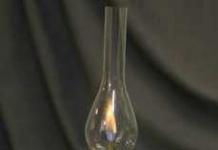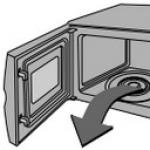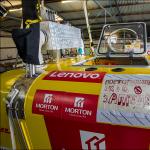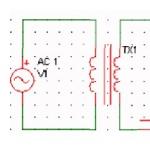The main types of balloons
According to the technical solution, balloons are divided into two main types. Gas-filled balloons French professor Jacques-Alexandre-Cesar Charles. Charles made the first unmanned flight on August 28, 1783. The first manned free flight on a gas-filled balloon took place on December 1, 1783, the pilots were Professor Charles himself and the mechanic Robert. In honor of the inventor, gas-filled balloons were for some time called charliers. The shell of a gas-filled balloon was filled with hydrogen, sometimes with cheaper methane. Now helium is used for this type of balloons. A thermal balloon, also called a hot air balloon, is arranged differently. In hot air balloons, the shell is filled with hot air or a steam-air mixture. To maintain a high air temperature inside the shell, hot air balloons are equipped with burners, most often operating on natural gas. The inventors of the hot air balloon are French manufacturers brothers Joseph and Etienne Montgolfier. Carried away by the natural sciences, the Montgolfier brothers on June 5, 1783 raised the first unmanned hot air balloon into the sky. On September 19 of the same year, they lifted animals on a hot air balloon. At a height of about half a kilometer, a ram, a duck and a rooster. The flight was successful, the possibility of a safe stay of a person in the sky was proved.First manned flight
The preparation of a manned flight required the Montgolfier brothers to equip their balloon with a firebox. While the experiments were going on, Etienne Montgolfier and the young physicist Pilatre de Rozier carried out the ascents on a tethered hot air balloon. On November 21, 1783, the first free manned flight of a balloon took place. On board were Pilatre de Rozier and the Marquis d'Arlande. The pilots regulated the temperature of the air in the shell by throwing straw into the firebox. The flight lasted about twenty minutes and went off safely. Thus, the priority in the invention of a manned balloon belongs to the brothers Etienne and Joseph Montgolfier. The first people to take to the air were the physicist Pilatre de Rozier and the Marquis d'Arlande.rubber balloon
The toy rubber also has an inventor. In 1824, the famous English physicist Michael Faraday glued together an elastic gas-tight shell from two rubber plates for hydrogen research. A few decades later, it was this bubble in the sky that became the favorite toy of children. Now, instead of combustible hydrogen, safe helium is used in balloons.It's hard to imagine, right, that a wicker balloon basket would cost as much as a new Rolls Roice - more than half a million dollars? But it is in such a basket that Fedor Konyukhov will fly on a solo trip around the globe. Of course, it is not wicker at all, stuffed with electronics and modern equipment, and looks more like a bathyscaphe than a good old balloon gondola ...
The gondola of the Morton balloon, on which Konyukhov will fly, was designed and manufactured specifically for this project in Bristol, England. It is both a cabin for controlling the flight of the ball, and a residential building for Fedor, and a lifeboat with full autonomy up to 7 days. Here is a navigation cabin, a place to sleep, a stove on which you can heat up food - this is the minimum of amenities that a pilot has in a gondola. It took almost a year to manufacture and fully equip the gondola, and the cost exceeded 500 thousand dollars.
To send such a non-standard and fragile cargo from Bristol, the forces of the express delivery network at the international level were involved. The itinerary was specially calculated taking into account the oversized dimensions of the gondola in such a way that only the largest DHL aircraft were used along the entire route, allowing such non-standard cargo to be loaded and transported safely. First, it was taken by road from Bristol to the East Midlands, then by plane followed the route: Bristol - Leipzig - Bangkok - Singapore - Sydney, and then from Sydney, the official Toyota Hilux expedition car delivered the gondola to the team's base in Northham.
See below what this technological basket looks like inside...
2. The gondola is made of heavy-duty and lightweight carbon fiber and has dimensions of 2x2.2x1.6m. You can get into the gondola through the hatch located on the roof, which also functions as a viewing window.
Two keels are installed under the bottom of the gondola to maintain buoyancy in case of an emergency landing in the ocean. Inside, the gondola resembles a lifeboat compartment with an autonomy of up to 7 days. 
3. As such, the gondola has no front and rear parts. But conditionally they can be defined as follows: where all the navigation equipment is located - the front part, and where the life support systems - the back.
The staging area looks impressive. The entire front panel is filled with displays, instruments and control switches.
Large multifunctional navigation display in the center console 
4. Navigation table and logbook on it.
Navigation equipment and radio communications are similar to those installed in the cockpit. Without them, it would be impossible to obtain permission to take off and fly in the zone of active air traffic. 
5. The gondola is equipped with an autopilot. Ask what this means, because the balloon has no wings, no elevator, and no rudder at all? The task of the autopilot is to keep the ball in a given range of heights, preventing it from leaving the air stream.
This is done using burner control. When necessary, the air under the shell of the ball is heated; when necessary, part of the warm air is vented. 
6. Working notes of Fedor Konyukhov for radio exchange with air traffic controllers. The letters here are not called the way we are used to, but according to the first sounds in English words: A - Alpha, B - Bravo, etc. Moreover, these words are clearly defined and used by air traffic controllers around the world. 
7. There is also an SOS button for the COSPAS-SARSAT global rescue system
This is an international satellite system, which is one of the main parts of the global maritime disaster rescue system and is designed to detect and locate ships, aircraft, and other objects that have crashed.
It functions as follows. A buoy of this system is bought, which, in fact, is a kind of "insurance policy".
Its cost is quite high, which allows the rescue system to accumulate very large amounts, which are directed, if necessary, to the organization of a rescue operation. Sometimes these surgeries cost hundreds of thousands of dollars.
The first practical case of rescuing people with the help of the system occurred on September 10, 1982, even at the stage of testing the technical means of the system, when the Soviet satellite Kosmos-1383 relayed a distress signal from a small aircraft that crashed in the mountains of Canada. An emergency signal via satellite was received by a Canadian ground station. As a result of the rescue operation, three people were rescued. By the beginning of 2002, more than 10,000 people had been rescued with the help of the COSPAS-SARSAT system. In 1998 alone, 385 rescue operations were carried out, resulting in the rescue of 1,334 people.
The number of rescue modules-buoys sold at the moment exceeds 1 million 
8. Management of the cabin life support system. It is equipped with a stove, because at an altitude of 5-10 km, on which the flight will take place for 2 weeks is very cold. Not a single down jacket will save, so you need to heat the air in the cabin.
For technical reasons, the cabin cannot be made airtight, like the cabin of an aircraft, so that it would be comfortable to stay in it for the entire two weeks of the flight.
The fact is that during the flight, Fedor will have to get out to the top of the gondola more than once to work with burners, unfasten empty gas cylinders and switch gas supply hoses from empty cylinders to full ones. 
9. The alarm clock that Fyodor had on the boat when he crossed the Atlantic and the Pacific Ocean on it. 
10. Working notes... They will come in handy there, in the sky, during the expedition 
11. The back of the gondola, it is household. Pockets for small things, heating pipes through which warm air will circulate 
12.
13. The internal volume is not as big as it might seem. In the front part there is a navigation panel, on the sides there are lockers, which at the same time are a sleeping place. In them, below, the necessary things, food, water supply are stored. 
14. The upper part of the gondola. It is no less technologically advanced than the internal one. This is a system of burners that must work flawlessly during the entire flight at extreme altitudes at extreme temperatures. 
15. Gondola suspension. Steel cables are passed through the carbon body through and through. 
16. The outer part of the stove. 
17. An entry point for cables coming from external navigation equipment. 
18. Burners from below during test runs. 
19. GPS transmitters are located about a meter from the gondola on the outer rods. Several GoPro cameras will be fixed here, powered on an ongoing basis. Management from a gondola by means of the DU panel. If you turn it on for permanent recording, the memory card will not last for a long time ... 
20. OKO telemetry module, which will monitor Fedor's flight.
This unique device was designed by the engineers of the Russian Technical Society, which is one of the technological partners in the preparation of Fyodor Konyukhov's round-the-world flight in the Morton balloon.
The device is a cube 17x17x17 cm. It is equipped with an on-board computer that will record flight characteristics and parameters: flight altitude, atmospheric pressure, GPS / Glonass coordinates, gondola speed, flight direction, ambient temperature, acceleration, roll, light level, radiation level, etc. In total, the module will monitor more than 20 different parameters. In addition, a photo-video camera is built into the device, which will take 1 picture every 2 minutes for two weeks of flight. Power supply is autonomous with solar panels. 
21. Every evening for a week, the expeditionary Toyota Hilux rolls out a trailer with a gondola from the hangar for Fedor Konyukhov to practice his skills in working with burners. In the evening light, it looks very beautiful! 
22. During the flight, Fedor will have to be constantly in warm overalls and use an oxygen mask for breathing. A huge oxygen tank will also be in the gondola. 
A series of reports on the preparation of Fedor Konyukhov's round-the-world expedition is carried out thanks to the sponsor of the expedition and the official car of the team
The name of this aircraft lighter than air speaks for itself. A huge shell of gas-impervious material - rubberized fabric or plastic - is inflated either with warm air, which, as you know, is lighter than cold air, or with a light gas (hydrogen or helium), and the balloon rises, dragging a basket with passengers.
A balloon inflated with warm air was called a hot air balloon - after the French brothers Joseph and Etienne Montgolfier. In the summer of 1783 they built a balloon, the first passengers of which were a ram and a rooster. The flight went well. After making sure that flights are safe, people began to fly on hot air balloons. The first such flight in November of the same 1783 was made by the French Pilatre de Rozier and d "Arlande. Thus began the era of aeronautics - flights on aircraft lighter than air.
Since hot air balloons did not fly very long - they went down as soon as the air cooled in them - flights on them were only purely entertaining. For flights with practical, military and scientific purposes, balloons inflated with hydrogen or helium began to be used. To observe a solar eclipse in 1887, the famous Russian scientist D. I. Mendeleev flew on such a ball.
Gradually, balloons began to make a variety of shapes. Therefore, the name - balloon - is outdated. In our time, all aircraft lighter than air are called balloons.
In the 30s. 20th century several high-altitude balloons were built, designed to study the upper layers of the atmosphere - stratospheric balloons. So that people could stay at high altitude for a long time, not suffer from a lack of oxygen, the gondola of the stratospheric balloon, in which the crew was located, was made airtight. Stratostats with such cabins reached a height of over 20 km.
However, a free-flying balloon is a toy of the wind. He does not fly where the crew wants, but where the air flow pulls him. Therefore, unguided balloons have not received wide distribution. They were replaced first by controlled balloons - airships, and then by heavier-than-air aircraft - airplanes and helicopters. True, during the first and second world wars, in the armies of many countries, tethered balloons connected to the ground surface with a strong steel cable were used as mobile observation posts, for hanging radio antennas, and air barriers against enemy aircraft.
At present, balloons are used in meteorology (see Meteorological technology) for launching automatic meteorological stations to high altitudes and for sports purposes. Modern durable gas-tight materials, gas burners, which allow maintaining a high air temperature inside the balloon without much trouble for a sufficiently long time, made it possible to achieve high safety in such sports flights. Athletes in balloons sometimes manage to overcome very significant distances. So, in 1978, a successful balloon flight across the Atlantic Ocean was made.
The balloon has neither motors nor the rudder we are accustomed to. Of the entire technological arsenal - only burners, sandbags and a special valve in the upper part of the dome for air etching. How to control this aircraft?
From the history of aeronautics
The birth of balloons was the first real embodiment of the age-old dream of mankind to conquer the fifth ocean. In 1306, the French missionary Bassu first described how, while in China, he witnessed the flight of a balloon during the accession to the throne of Emperor Fo Kien.
However, the French town of Annone is considered the birthplace of aeronautics, where on June 5, 1783, the brothers Etienne and Joseph Montgolfier raised into the sky a spherical balloon created by them filled with heated air.
The flight of an aircraft weighing about 155 kg and a diameter of 3.5 meters lasted only 10 minutes. During this time, he covered about a kilometer at a 300-meter height, which was an outstanding event for his time. Later, balloons in honor of the creators began to be called hot air balloons.
The balloon of the Montgolfier brothers consisted of a linen shell covered with paper. To fill it with hot air, a fire was made from finely chopped straw. And 3 months later, an addition was made to the design of the aircraft in the form of a special basket for passengers.

Modern balloons are undoubtedly more perfect, but they are made in almost the same way. For the manufacture of the spherical shell of the ball, a special thin and durable polyester material is used. The air heating system has changed. The function of the fire is performed by an adjustable propane gas burner installed in a basket directly under the dome.
Despite being heavily dependent on the wind, modern hot air balloons are manageable. The flight height is adjusted by an outlet at the top of the canopy with a break cord. A side valve is provided to change course. There are also more complex designs, where another one filled with helium can be placed inside the main dome.
How to fly a balloon with a basket
Balloon control is an activity that requires serious preparation and considerable financial costs. Suffice it to say that a balloon pilot training course today costs about 200,000 rubles. The price of the balloon itself (depending on the model) is commensurate with the price of a car.
Preparation
The flight is preceded by careful preparation. First of all, it is necessary to study the weather conditions - cloudiness, visibility and wind speed. In accordance with the received data, the flight route is planned. Due to unforeseen changes in weather conditions, it is precisely such a route that is chosen where there are enough places on the way for safe landings.

Takeoff
In order for the balloon to take off, the efforts of the entire crew are necessary. The best option for a starting point is a flat area 50 x 50 meters in an open field, where there are no extraneous objects nearby - poles, trees, power lines.
Then the assembly of the ball begins: burners are attached to the basket, which are connected with special hoses to gas cylinders. After a test run of the burner, the crew proceeds to stretch the canopy (necessarily in the direction of the wind). Further, the stretched dome is fastened to the basket with special carabiners.

The next step is to fill the dome with cold air using a fan, after which the burner is started to heat the air. The heated air lifts the dome from the ground, and the crew (with passengers) takes their seats. To prevent the ball from flying away, it is first tied to the car.
Flight
Despite the lack of a motor and wings, the balloon is controllable, which requires certain skills. The main controls are the burners and the exhaust valve. To climb, the burner turns on and the air heats up additionally, and to descend, the valve opens slightly. Horizontal flight occurs due to a tailwind. This is where the skill of the pilot comes into play. So, in order to fly faster, he can increase the flight altitude where the wind speed is stronger.

Descent
The landing site is chosen in advance. It must be large and secure. The ideal option is a football field next to the highway. The crew reports the landing site by radio to the ground. Next, the pilot releases air from the dome using a valve. The ball slowly falls to the ground.


















